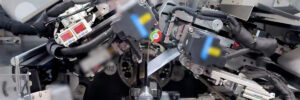LG Energy Solution, Tesla build LFP battery plants in the US

Lithium iron phosphate (LFP) batteries are all the rage these days. Although they offer lower energy density than batteries based on NMC (lithium nickel manganese cobalt) chemistries, they tend to be cheaper, and their ingredients are more readily available, less toxic and less controversial. Automakers including Ford and Stellantis are steadily building production capacity for LFP cells in the US and Europe (generally in cooperation with Asian battery-makers).
LG Energy Solution has unveiled a new facility in Holland, Michigan to produce LFP batteries at scale. The company established its first gigawatt-size battery plant in Holland in 2012.
The new plant is producing LFP batteries specifically for energy storage systems (ESS)—stationary batteries, not battery packs for EVs. (LFP cells offer long cycle life, making them especially suitable for ESS applications.) Average annual production capacity is expected to be 16.5 GWh. The $1.4-billion plant is expected to employ up to 1,700 people
“We have a solution where we can provide energy storage in any location where the energy is being produced and where it can be used in an efficient way to optimize the grid,” said Bob Lee, President of North America for LG Energy Solution, adding that the company is prepared to more than double its current capacity if demand grows.
The Holland facility will also produce NMC cells and modules for the Ford Mustang Mach-E, which LG Energy Solution previously produced in Poland.
LG Energy Solution currently owns four battery manufacturing facilities in the US—two in Holland, one in Lansing, and one in Queen Creek, Arizona.
CleanTechnica’s Paul Fosse got a chance to tour the new plant and observe the manufacturing process: creating slurry, coating foil, stacking cells with safety-reinforced separators, sealing in aluminum pouches and injecting electrolyte. The process is now operational on two lines, and a third is expected to go into service by the end of the year.
Meanwhile, Tesla says it is “nearing completion” of its own new LFP battery manufacturing facility, near its Gigafactory Nevada.
While Ford entered a technology licensing agreement with Chinese battery giant CATL for its Michigan battery plant, Tesla purchased manufacturing equipment from the company, a strategy that has allowed Tesla to avoid the political complications that have plagued Ford’s CATL partnership.
Battery Technology’s Michael C. Anderson says video footage released by Tesla appears to confirm that the company has implemented a wet coating process for electrode manufacturing at the Nevada facility. This matches CATL’s predominant manufacturing methods for LFP, but contrasts with the dry coating process that Tesla is developing for its 4680 cells in Texas.
Tesla’s new facility is expected to start with approximately 10 GWh of annual production capacity. The initial output is expected to be used in stationary storage products such as Tesla’s Powerwall and Megapack rather than in EVs—the same approach taken by LG Energy Solution with its new Michigan LFP facility.
Sources: Tesla, CleanTechnica, Battery Technology
